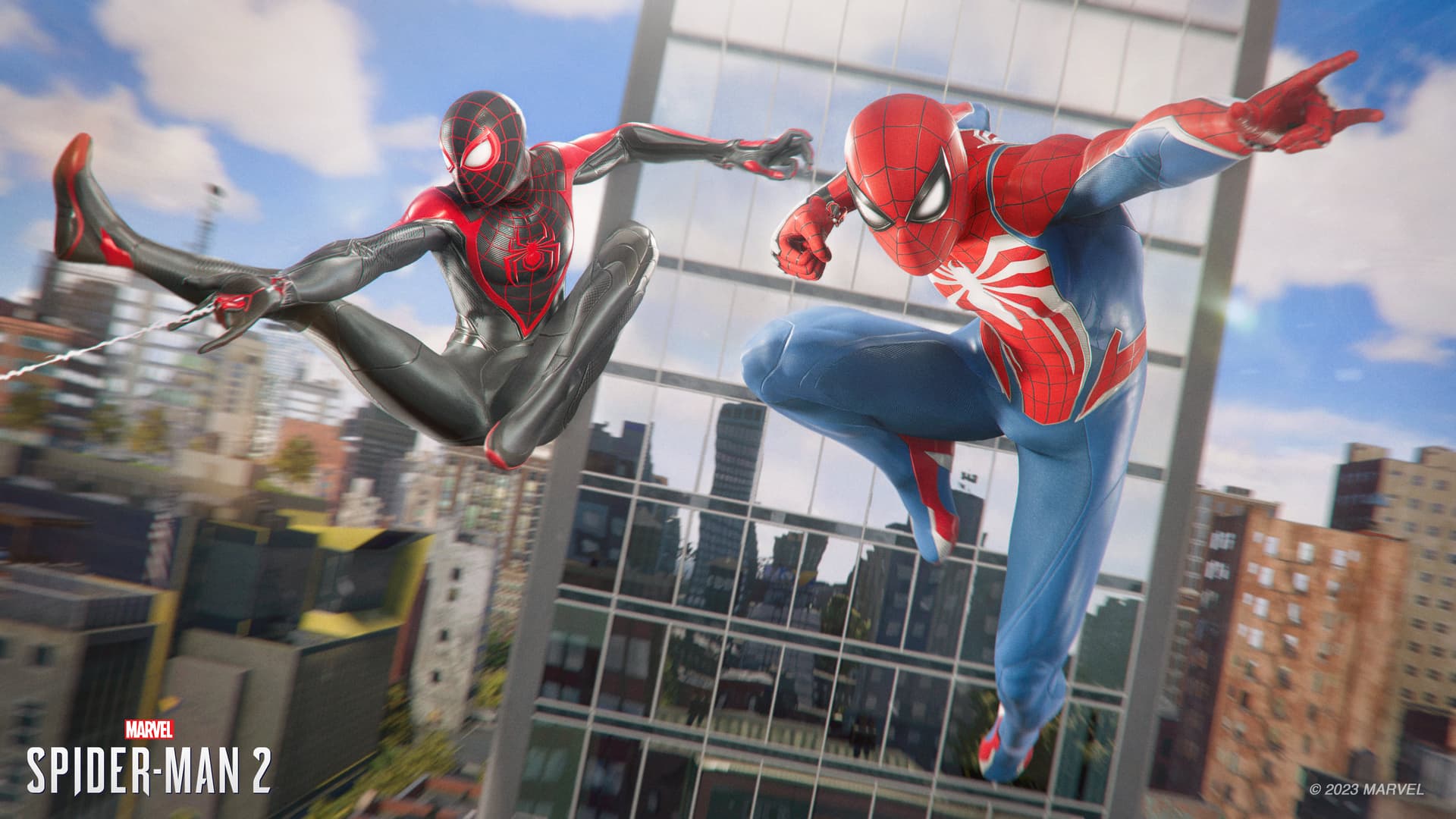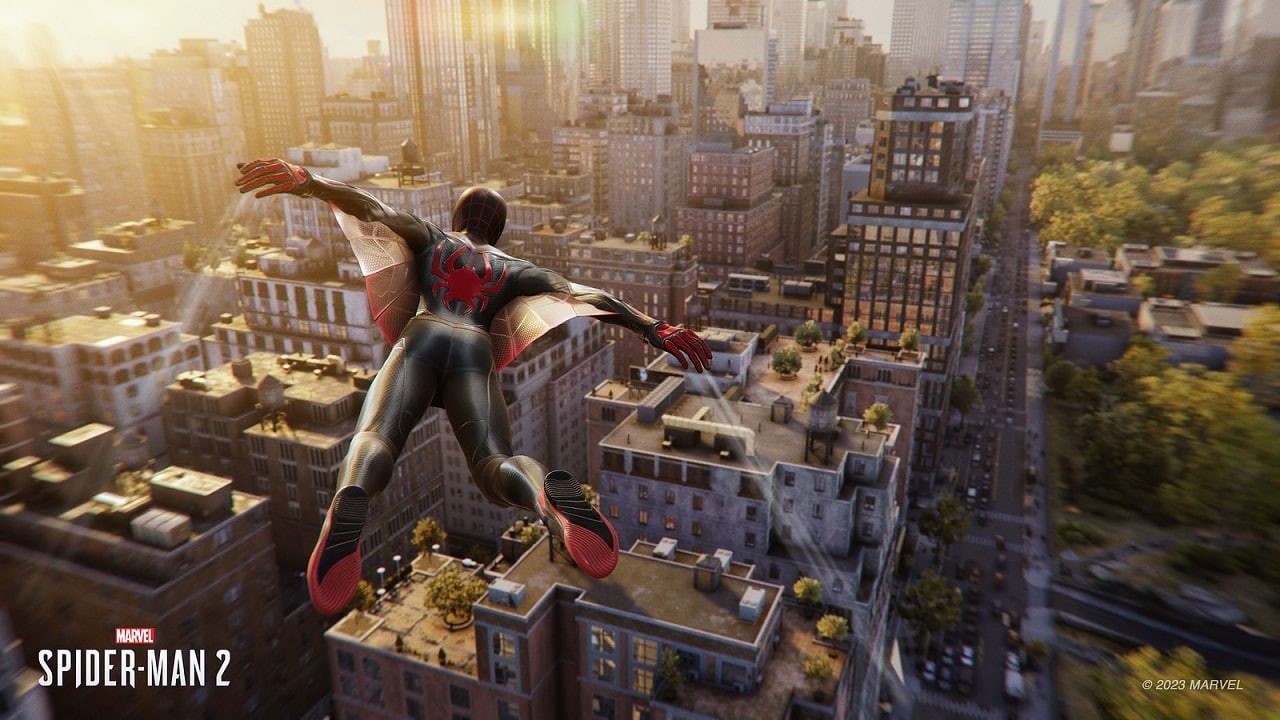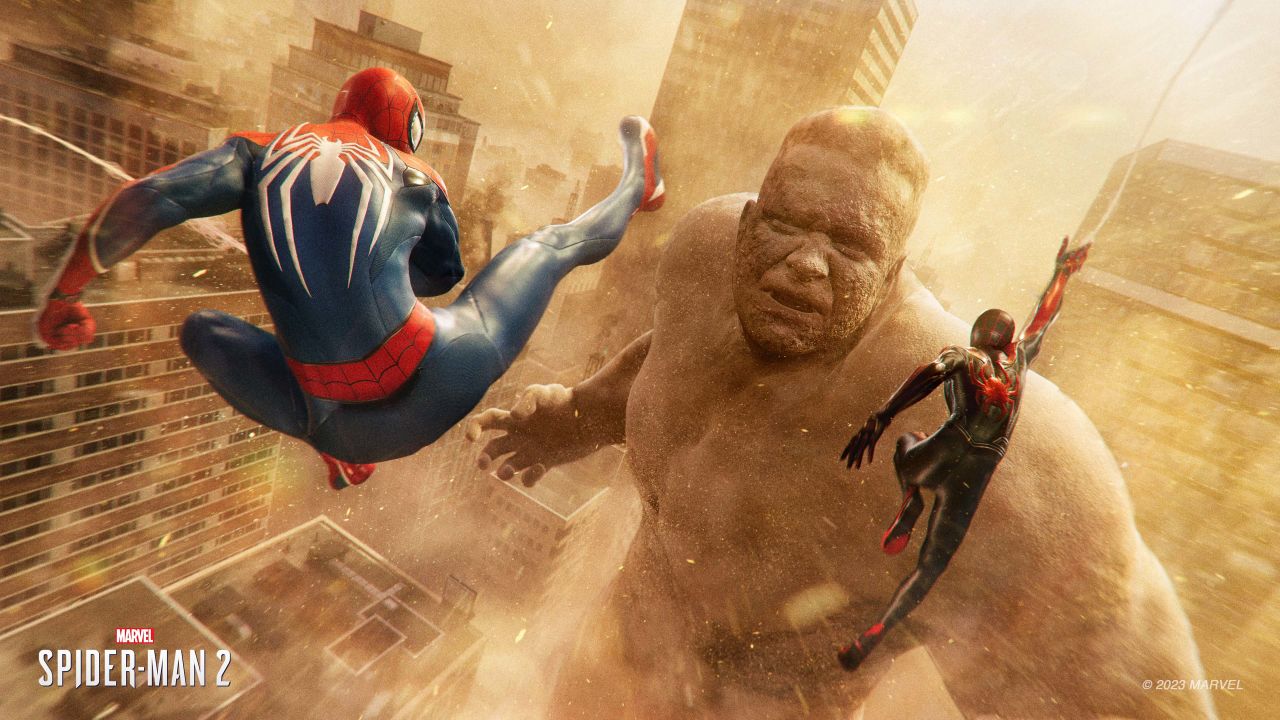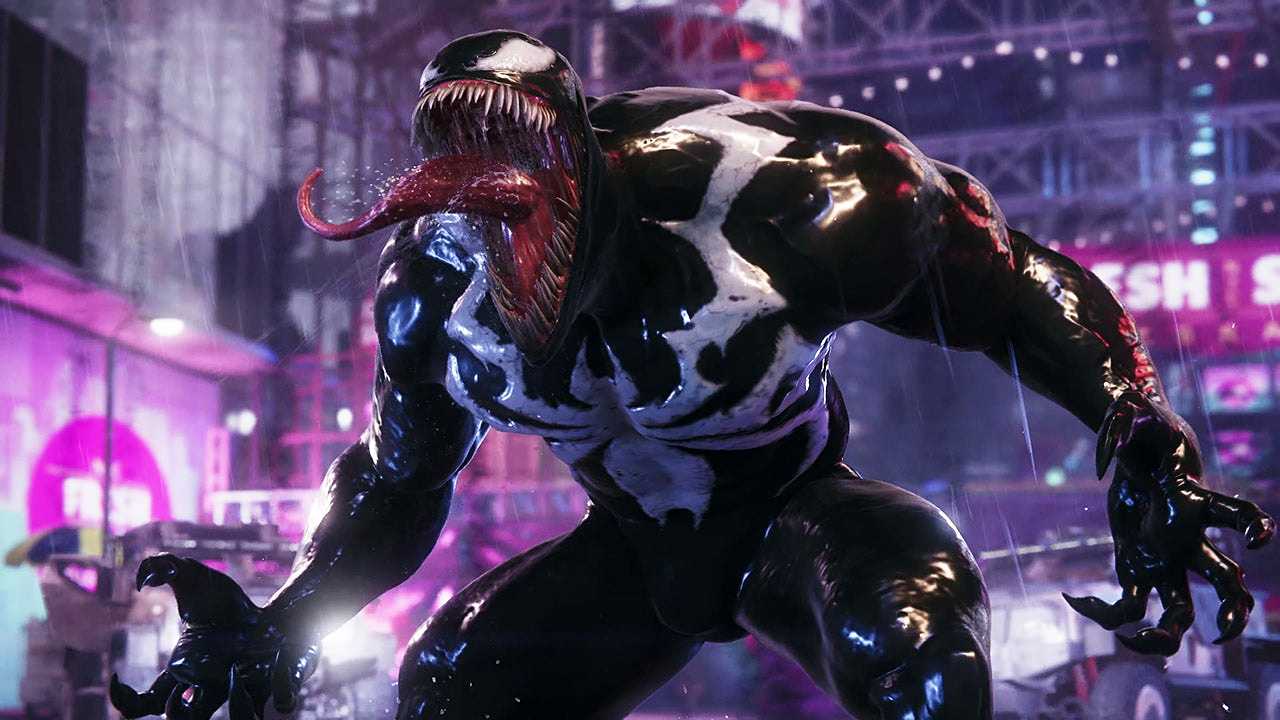Title – Marvel’s Spider-Man 2
Platforms – PS5
Release Date – October 20, 2023
Developer – Insomniac Games
Publisher – Sony Interactive Entertainment
MSRP – $69.99
ESRB – T for Teen
Disclaimer – Gaming Instincts is an Amazon Affiliate and does gain financial benefits if you choose to purchase this product on this page.
Marvel’s Spider-Man 2 tackles the Symbiote storyline, which consistently proves to be a difficult endeavor; it has the weakest plot of all three games. There is, however, little room for criticism when it comes to the gameplay and open-world design, both of which improve what was nearly perfect in the first game.
The Story: Excellent Characters, Bad Plot
Venom is a favorite Spider-Man villain of mine, primarily due to his unmatched brutality and strength compared to most of the rogues’ gallery. Alongside Venom, we also encounter the symbiote suit, a simple yet effective symbol of our unchecked darker desires.
However, crafting a storyline for Venom can be a challenging task. The symbiote is an evil alien, heavily reliant on the depth of the host for any semblance of nuance. Furthermore, Peter Parker’s descent into darkness is often portrayed in a cheesy and hard-to-watch manner. The adaptation in Marvel’s Spider-Man 2 is an improvement over the infamous movie, Spider-Man 3, but still falls short in various aspects.
At the heart of the narrative is the return of Harry Osborn, a childhood friend of Peter and Mary Jane. The bond between Peter and Harry is one of the story’s standout elements. It’s a welcome surprise when writers can create a deep, platonic, and loving friendship between characters. The rapport between Harry and Peter is convincing, whether it’s their enjoyable bike rides through the streets of New York or their geek-out sessions in Harry’s lab. The same is true for the entire trio’s relationships; Peter, Mary Jane, and Harry share a genuine friendship without the unnecessary drama that some stories force into friend triangles.
While Miles Morales is the co-protagonist, Peter plays a more substantial role in advancing the plot due to his central relationship with Harry. Regrettably, Miles’ storyline feels somewhat basic and less critical to the overarching narrative. Miles grapples with the familiar theme of revenge as he confronts the return of Martin Li, who killed his father in the previous game. At this point, a surface-level revenge storyline is overdone, and Spider-Man 2 does nothing to make it interesting.
Moreover, Peter’s storyline offers a more well-rounded conclusion. In addition to the Li predicament, Miles grapples with the tension between his dual personas, yet this conflict reaches a contradictory, ill-thought-out conclusion. Miles is a fantastic character, characterized by his childlike innocence, intelligence, and humor. It’s particularly refreshing to see moments when he outshines Peter both in combat and emotional stability. Miles often takes on the role of guiding Peter through his emotions, transforming from a mentee into an equal. While the game does an excellent job of highlighting Miles’ strengths as a character, it doesn’t provide him with equally compelling plot points to explore.
In addition to Venom, Kraven is another significant antagonist throughout the game. He is portrayed as an intimidating and seemingly unstoppable force, and his characterization is remarkably well-executed. Kraven exudes ruthlessness and captivates the audience in every scene he appears in. However, he remains one-dimensional, solely driven by the pursuit of a worthy adversary. While it’s acceptable to have such characters, the lack of complexity in Kraven makes him appear underdeveloped despite his gravitating presence.
When examining Spider-Man 2’s storyline, a recurring issue becomes evident: strong characters paired with a mediocre storyline. The same holds for Venom. The character is impressively well-crafted, from his design to his personality. His brutality and fear factor is surprising for a rated T game. Personality-wise, he doesn’t come off as a goofy character making jokes all the time; instead, he’s intimidating with a touch of cheesiness. Unfortunately, the goals of Venom, as well as his host’s goals, lack coherence. While I grasp the game’s intentions, there’s a noticeable disconnect between Venom’s actions and his objectives.
Spider-Man 2’s story has tons of issues. One of the biggest is its lack of risks. The ending of Marvel’s Spider-Man threw a curveball that thwarted our expectations for a Spider-Man story. However, in the sequel, I accurately guessed almost every plot point, leading to a lackluster and uninspiring story.
It lacks proper development, leaving character motivations unexplained and character arcs unsatisfactorily resolved, especially in the case of Miles. The characters themselves, on the other hand, are exceptionally well-crafted in terms of both writing and performance. I loved every member of the main cast and smiled ear to ear when I watched them interact with each other. Even the occasionally irritating portrayal of Symbiote Spider-Man doesn’t cross the line into unbearable cheesiness.
Gameplay – Almost Perfect
Let’s begin by discussing the mission types before diving into specific gameplay mechanics. The central part of the game revolves around exceptionally executed story missions. In most open-world games, you encounter missions designed for the genre, such as fetch quests or combat scenarios scattered throughout the city. These missions lack the depth and nuance typically found in more linear games. However, Spider-Man 2 manages to strike a remarkable balance between a captivating open world and levels that could easily belong in a linear action-adventure game like Uncharted.
The exceptional level design becomes evident from the start, as the two Spider-Men face off against a formidable Sandman, who hurls concentrated sand projectiles and destroys everything in his path. One unforgettable moment saw Sandman tossing Miles across the entire city, with the camera seamlessly following him the entire way. This spectacle rivals the epic scale in the original God of War trilogy and sets the standard for how seriously Insomniac takes their missions.
Not every mission is a grand set piece, but each offers something unique and engaging. Spider-Man 2 pleasantly surprised me with its diverse range of tasks, and each one is treated with the same meticulous attention to detail. Whether you are riding rollercoasters with Harry and MJ at Coney Island or guarding a high-level prisoner transport, the missions feel fresh and captivating. Many take place inside buildings, where you’ll forget you’re playing an open-world game as you crawl across ceilings and engage in battles in carefully crafted spaces you won’t encounter again.
One standout mission takes a page from the rift-tearing in Ratchet and Clank Rift Apart. You’re instantly transported across the map by passing through portals during a high-speed chase scene. It’s moments like these that made me realize that Spidee-Man’s missions might be the best I’ve ever experienced in a non-linear game. I can’t emphasize enough how each mission kept me engaged and excited for what was coming next, whether it was a boss fight against The Lizard or an exploration of a college campus as Miles.
The infamous MJ missions make a return, and they represent a significant improvement from the first game. Her missions primarily focus on stealth, but they never overstay their welcome. The level design offers various routes and options, and surprisingly, the stealth mechanics are as good, if not better, than some basic stealth games like Assassin’s Creed. Instead of an inconvenience, these missions serve as a refreshing departure from web-slinging and crime-fighting.
There’s a spectacle you miss out on by not witnessing everything as a mere human. Often, when you’re playing as MJ, superhero antics unfold around you. It’s fascinating to observe the action from a different perspective and witness the sheer spectacle of Spiderman’s heroics from a street-level view. There was a point later in the game where I initially groaned at the prospect of another MJ stealth sequence. However, to my surprise, the mission transformed into a thrilling third-person shooter, which I thoroughly enjoyed.
Lastly, many of the set pieces involve boss battles. These boss fights are finely tuned in terms of difficulty. While you don’t necessarily expect an overly challenging experience in an open-world superhero game, a bit of a challenge adds to the enjoyment. The boss fights are never frustratingly difficult, typically requiring only a couple of attempts to defeat, but they do demand careful attention to the enemy’s attack patterns and well-timed dodges and parries. Playing on the normal difficulty setting, I found the level of challenge in the boss fights just right, providing relevance without unnecessary frustration.
Now, let’s swing over to explore the side content. Optional activities in Spider-Man are extremely manageable to the point where I finished almost all of the collectibles and side missions when I was only 50 percent through the main campaign. It didn’t even take too long to complete it all. As someone who gets overwhelmed by extra content, this was mostly a plus, but even I was wishing for just a little more to do. On the bright side, everything there is really good.
One small change from the first game is that when a series of collectibles are unlocked, it doesn’t automatically take you to the map and plot down all the icons. Side content and collectibles are more exploration-based this time around, meaning that as you swing around the city, icons will pop up in your field of view. It’s a small thing, but it is one of my favorite improvements from the first game. It’s amazing how this simple change can make the collectibles less like a checklist. The feature in no way makes the side content harder to find. You can easily 100 percent the game without looking at the map, a good quality in any open-world game.
The primary and most common activity revolves around handling crimes that occur randomly in the city. You might intervene in a mugging, chase down a speeding car, or confront a group of arsonists. Similar to the first installment, these crimes immerse you in the role of Spider-Man, compelling you to interrupt your ongoing tasks to stop various criminal activities. This dynamic significantly enriches the city’s ambiance as you explore or swing toward your next mission. What enhances this experience further is that the other Spider-Man can spontaneously join your efforts or are already present, engaged in thwarting criminals. This small but impactful feature truly conveys the sensation of both Spider-Men actively patrolling the city.
The photo side mission also makes a welcome return, and I found it more enjoyable than most photography missions in open-world games. These missions typically guide you to specific activities or intriguing points of interest in the city. They excel in grounding New York City and reminding you that ordinary people continue with their daily lives. My only lament is that there weren’t more photos to take, and I felt a pang of sadness when I snapped my final shot, as I yearned to keep exploring the wonders of New York City.
There are several other collectible-style activities that I won’t delve into here. I will simply mention that I was impressed by the substantial nature of each of them. Nothing felt like mere filler, as everything either contributed to the main storyline or set the stage for future developments in the franchise. Some side missions follow specific villains from Spider-Man’s rogue gallery and culminate in significant revelations or moments. I was not disappointed by any side mission or set of collectibles.
Furthermore, there is a set of side missions that offer surprising depth and emotional resonance. One such mission has you swinging through the city while a flock of pigeons soars around you, accompanied by a poignant tune. All the side missions share this endearing quality, offering some of the most heartwarming moments in the game. These are experiences you won’t want to miss.
Now, let’s dissect the gameplay mechanics, categorizing them into different tiers. First, traversal, which is nothing short of excellent. You can effortlessly attach your web to a building, swing through the air, execute aerial tricks, and shoot another web to continue your momentum. This requires timing but maintains a user-friendly approach, making it one of the finest traversal mechanics in any open-world game. Although a fast travel system exists, I never used it because the swinging mechanics were just that exceptional.
As you progress, you can unlock upgrades to your swinging abilities, such as quickly navigating around corners and launching yourself from the ground. Notably, there’s a setting to customize your swing assist, allowing for an easier, physics-defying experience or a more challenging, momentum-based one. Regardless of your choice, swinging remains exhilarating.
When you’re not swinging, your primary activity is engaging in combat. It follows a straightforward Arkham-style combat system, involving well-timed attacks and dodges. The complexity comes from the array of abilities and gadgets at your disposal. You can juggle enemies in the air, execute mid-air attacks, web enemies together and swing them around, or perform aerial swing kicks. There’s enough variation in combat for each player to adopt their unique style, whether emphasizing aerial combat or utilizing gadgets. One of my favorite gadgets was the one that pulled all enemies and objects with webs into a central point.
I must admit that I preferred the gadgets in the first game, particularly the trip mine, web bomb, and impact web, which led to more entertaining scenarios, such as immediately webbing foes to walls. The gadgets in the sequel certainly get the job done, but none were that captivating except for the web grabber.
On the other hand, the abilities represent a substantial improvement from the original and effectively emphasize the contrast between Miles and Peter. Miles’ electrical abilities shine until Peter acquires the symbiote suit. You can chain electrical attacks across multiple enemies, leap into the air, perform an electric ground pound, and pull and push enemies using electrical shocks. Combining abilities with gadgets and standard punches creates diverse and enjoyable combat scenarios where you can string the best combos together.
The symbiote suit, without a doubt, lives up to the hype. It allows you to extend your fists for long-range punches, gather and slam multiple enemies into the air, and exude a sense of power and aggression, aligning perfectly with the narrative of becoming a stronger Spider-Man. This suit adds a significant and impactful change from the base Spiderman experience.
The final tier of gameplay involves stealth, and the web line makes it far more manageable. Much like a gadget in the Arkham games, you can shoot a web across a gap and walk across it, granting access to typically inaccessible takedowns. It’s immensely satisfying to string up a network of web lines across the sky and dangle enemies from them. Additionally, a returning mechanic allows you to assess if enemies are safe for a stealth takedown, streamlining the process and expediting stealth encounters. While stealth is rarely mandatory, it remains a viable approach to initiate combat encounters if you opt for a covert strategy.
Before moving on, I’d like to address a few other minor aspects. Suits make a return, with a plethora of options for both characters, each distinct from the last. Unlocking a new suit always incites excitement, especially with the choice of four color variations for each one. You can select an impressive-looking one or a comical one, catering to various preferences. One disappointment is that the suits no longer come with their unique abilities. Part of the fun in the first game was discovering the distinctive powers that accompanied each suit. For instance, the Spider-Punk could play a guitar to unleash a sonic shockwave. I understand these powers might be overwhelming considering the abilities already possessed by the base Spider-Men. Nevertheless, I found myself missing them.
Certain other features from the first game did not carry over to the sequel, such as the absence of a selfie mode and the inability to change the weather during free-roam gameplay. It struck me as odd that these features were omitted, particularly the selfie mode, which became an iconic addition in the initial game. These may be minor details, but in conjunction with the reduced amount of side content, I wonder how much didn’t make the final cut. However, it’s important to note that the game is far from incomplete, offering enough content to justify its release. It’s just peculiar that these particular features didn’t make the final cut.
Graphics and Performance – The Best-Looking Game on the PS5
Spider-Man 2 offers two distinct visual settings: performance and fidelity. My initial choice was performance mode, my default preference. This mode maintains a mostly steady 60 frames per second with occasional, minor dips, all while delivering a 1440p resolution. It’s worth noting that the performance mode still incorporates ray-traced reflections, albeit not as intricately detailed as the fidelity option. Even in performance mode, Spiderman 2 is one of the most visually stunning games on the PS5.
I decided to venture into fidelity mode at one point during my playthrough. This mode aims for a fixed 30 frames per second, featuring native 4K resolution, heightened crowd and traffic density, and superior hair textures. The visuals in this mode were so breathtaking that I remained in fidelity mode for the remainder of my game. While I usually favor higher frame rates in most games, the 30 FPS in Spiderman 2 strangely didn’t diminish my enjoyment. The visual quality, in either mode, is beyond reproach.
Throughout my time with the game, I did encounter several bugs, with the most notable being an invisible wall blocking my path in a hallway. A quick save reload allowed me to bypass this obstacle, and I never encountered any game-breaking bugs necessitating a complete game restart. While I did have to restart a few checkpoints to work around issues, these were relatively minor and didn’t significantly detract from my overall enjoyment.
Final Verdict
Marvel’s Spider-Man 2’s storyline was disappointing, despite the compelling characters. However, the gameplay experience is nothing short of exceptional. It’s so captivating that I found myself yearning for more of it. Although the game falls short in terms of the quantity of open-world activities, it excels in quality. All considered, Marvel’s Spider-Man 2 earns a commendable 8.5 out of 10.
Stay tuned at Gaming Instincts via Twitter, YouTube, Instagram, and Facebook for more gaming news.







